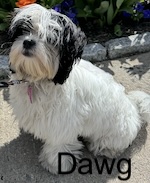Barnie the adult fawn Basset Fauve de Bretagne
The Basset Fauve de Bretagne is one of the smallest French hounds with a typical basset shape, a long body with short legs. Its head is rather long, being broadest between the ears, tapering in width to the eyes. It is slightly flattened on top and arched on the sides. The stop is moderate, but a little more than in the Griffon Fauve de Bretagne. The muzzle is the same length as the skull, tapering slightly in width from the stop to the nose. Its lips well cover the lower jaw, but there is no excess of flew. The strong teeth meet in a tight scissors bite. The dark brown eyes are set well into the skull, neither prominent nor too deep, with no haw visible. The eye rims are fully pigmented. The nose is either black or dark brown. The drop ears are set low, on a line with the eye. When pulled forward, they reach just to the end of the nose. The ears taper to a point at the end and turn inwards. They are covered with shorter, softer hair than that on the rest of the dog. The neck is rather short and well-muscled with no dewlap. The body is deep and broad, with a moderately rounded ribcage. The back is rather short for a Basset, broad, strong and level. The loin is wide and muscular with little tuck-up. The medium length tail is strong at the base, tapering to a point. The Basset Fauve de Bretagne has a dense, wire-coat that is very harsh to the touch. Coat colors come in warious shades of fawn, from golden wheaten to brick red. A few black hairs on the ears or the back are acceptable in the show ring, but not desirable, as is a small white spot on the chest.
The Basset Fauve de Bretagne is a small hunting, hound dog. The breed is sweet, friendly, lively, gentle and devoted making an excellent companion dog. Its temperament should always be friendly, and never vicious, moody or harsh, and would only become so if the owners lead the dog to believe he is pack leader over humans. It is mild but not timid; very affectionate with its master and friendly with children. It can be a bit stubborn with meek owners and needs a firm, confident, and consistent owner who displays natural authority over the dog. Dogs need to know the rules of the house and have the humans stick to them. Bassets like to do tricks for food. They have a deep musical bark. Housebreaking can be difficult, but they do well with patient, gentle training. This courageous dog is a serious, determined hunter. They can easily adapt to different types of game and terrain. With proper training, they are obedient, but when they pick up an interesting smell, it's sometimes hard to get their attention, as they like to follow their noses and may not even hear you calling them back. Only allow your Basset off lead in safe areas.
Height: 12 - 15 inches (30 - 38 cm)
Weight: 25 - 35 pounds (11 - 16 kg)
Prone to reproductive problems, ear infections, eye problems such as corneal ulcers and cataracts. Also can have heart and kidney problems. Some lines are prone to epilepsy.
The Basset Fauve de Bretagne will do okay in an apartment. They are inactive indoors but outdoors they will run for hours in play if given the chance. They will do okay without a yard, but should be given plenty of opportunities to run and play to keep healthy and trim.
To keep the Basset Fauve de Bretagne healthy, it should be given plenty of exercise, including a long daily walk to keep the dog mentally stable, but discourage it from jumping and stressing the front legs. This breed will run and play by the hour when given the chance. Because of their keen noses they tend to roam when they pick up a scent. Take care when off lead that the dog is in a safe area. When they pick up a scent they may not even hear you calling them back as their complete focus will be on finding the critter at the other end.
About 11- 14 years
About 6 puppies
The harsh, dense, wire-coat is fairly easy to groom and sheds little to no hair. Simply brush regularly with a stiff bristle brush. Brushing should keep the coat clean, so bathe only when necessary. Trim around the ears and eyes with blunt-nosed scissors. The whole coat should be trimmed about every four months and stripped twice a year.
This breed was created in Brittany, France from the now extinct Grand Fauve de Bretagne.
Hound
Barnie the adult fawn Basset Fauve de Bretagne
Barnie the adult fawn Basset Fauve de Bretagne
Barnie the adult fawn Basset Fauve de Bretagne
Barnie the adult fawn Basset Fauve de Bretagne with his coat stripped.
Barnie the adult fawn Basset Fauve de Bretagne with his coat stripped.
Barnie the adult fawn Basset Fauve de Bretagne with his coat stripped.
